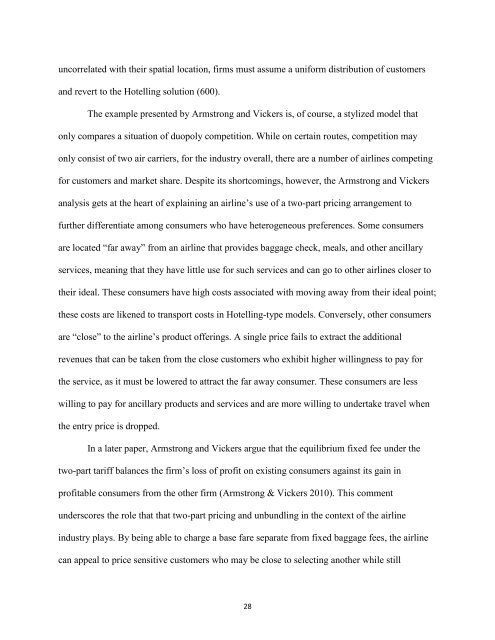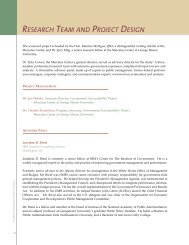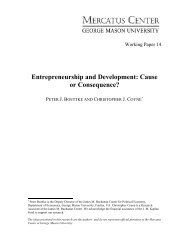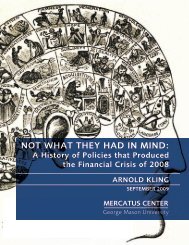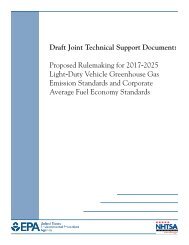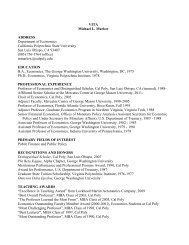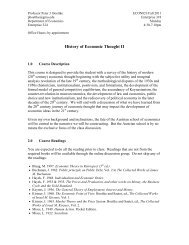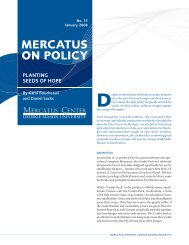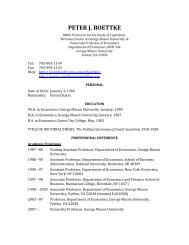A-La-Carte Pricing in the Airline Industry - Graduate Student ...
A-La-Carte Pricing in the Airline Industry - Graduate Student ...
A-La-Carte Pricing in the Airline Industry - Graduate Student ...
You also want an ePaper? Increase the reach of your titles
YUMPU automatically turns print PDFs into web optimized ePapers that Google loves.
uncorrelated with <strong>the</strong>ir spatial location, firms must assume a uniform distribution of customersand revert to <strong>the</strong> Hotell<strong>in</strong>g solution (600).The example presented by Armstrong and Vickers is, of course, a stylized model thatonly compares a situation of duopoly competition. While on certa<strong>in</strong> routes, competition mayonly consist of two air carriers, for <strong>the</strong> <strong>in</strong>dustry overall, <strong>the</strong>re are a number of airl<strong>in</strong>es compet<strong>in</strong>gfor customers and market share. Despite its shortcom<strong>in</strong>gs, however, <strong>the</strong> Armstrong and Vickersanalysis gets at <strong>the</strong> heart of expla<strong>in</strong><strong>in</strong>g an airl<strong>in</strong>e‘s use of a two-part pric<strong>in</strong>g arrangement tofur<strong>the</strong>r differentiate among consumers who have heterogeneous preferences. Some consumersare located ―far away‖ from an airl<strong>in</strong>e that provides baggage check, meals, and o<strong>the</strong>r ancillaryservices, mean<strong>in</strong>g that <strong>the</strong>y have little use for such services and can go to o<strong>the</strong>r airl<strong>in</strong>es closer to<strong>the</strong>ir ideal. These consumers have high costs associated with mov<strong>in</strong>g away from <strong>the</strong>ir ideal po<strong>in</strong>t;<strong>the</strong>se costs are likened to transport costs <strong>in</strong> Hotell<strong>in</strong>g-type models. Conversely, o<strong>the</strong>r consumersare ―close‖ to <strong>the</strong> airl<strong>in</strong>e‘s product offer<strong>in</strong>gs. A s<strong>in</strong>gle price fails to extract <strong>the</strong> additionalrevenues that can be taken from <strong>the</strong> close customers who exhibit higher will<strong>in</strong>gness to pay for<strong>the</strong> service, as it must be lowered to attract <strong>the</strong> far away consumer. These consumers are lesswill<strong>in</strong>g to pay for ancillary products and services and are more will<strong>in</strong>g to undertake travel when<strong>the</strong> entry price is dropped.In a later paper, Armstrong and Vickers argue that <strong>the</strong> equilibrium fixed fee under <strong>the</strong>two-part tariff balances <strong>the</strong> firm‘s loss of profit on exist<strong>in</strong>g consumers aga<strong>in</strong>st its ga<strong>in</strong> <strong>in</strong>profitable consumers from <strong>the</strong> o<strong>the</strong>r firm (Armstrong & Vickers 2010). This commentunderscores <strong>the</strong> role that that two-part pric<strong>in</strong>g and unbundl<strong>in</strong>g <strong>in</strong> <strong>the</strong> context of <strong>the</strong> airl<strong>in</strong>e<strong>in</strong>dustry plays. By be<strong>in</strong>g able to charge a base fare separate from fixed baggage fees, <strong>the</strong> airl<strong>in</strong>ecan appeal to price sensitive customers who may be close to select<strong>in</strong>g ano<strong>the</strong>r while still28


